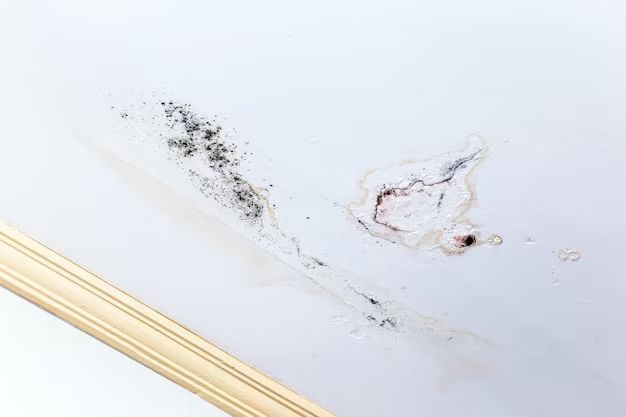Black mold is a common problem in many homes. It can grow on ceilings, walls, floors, and other surfaces. Black mold is also known as Stachybotrys chartarum. It’s a greenish-black mold that grows in damp areas indoors. Exposure to black mold can cause health issues like coughing, wheezing, stuffy nose, eye irritation, and skin rash. Getting rid of black mold completely requires removing the mold and fixing the moisture issue that allowed it to grow. Here are some steps you can take to remove black mold from your ceiling.
Page Contents
What causes black mold on ceilings?
Excess moisture is the main cause of black mold growth on ceilings and elsewhere in homes. Sources of moisture that lead to mold include roof leaks, humidity from cooking and showering, plumbing leaks, condensation, and flooding. If the moisture isn’t addressed, black mold can keep returning even after you clean it off. Reduce indoor moisture to prevent future mold growth after removing existing mold.
How to get rid of black mold on ceilings
Prepare for safety
Take precautions to limit your exposure to black mold spores during the removal process:
- Wear gloves, goggles, and an N95 respirator mask.
- Seal off the affected area with plastic sheeting.
- Turn off forced-air heating and air conditioning systems.
- Open windows for ventilation.
Identify and eliminate moisture sources
Finding and fixing moisture problems is crucial for preventing black mold from returning after cleanup. Sources to check include:
- Roof and plumbing leaks.
- Overflowing gutters.
- High indoor humidity.
- Flooding.
- Condensation on cold surfaces like windows and pipes.
Consult a contractor if the source isn’t clear. They can identify hidden leaks and other issues. Fix all moisture problems before cleaning mold.
Scrub off surface mold
Start by scrubbing off surface mold from ceilings and walls. This step removes the easy mold before moving on to other treatments. Use a stiff brush or scrub pad and a detergent mixed with warm water. Scrub until all visible mold is gone. Completely dry all scrubbed surfaces with towels.
Use a mold killing solution
After physical scrubbing, apply a commercial mold killing solution. Look for products that contain bleach or hydrogen peroxide. Spray or mop the solution onto affected ceilings, walls, and other surfaces according to product directions. Let it sit for 10-15 minutes so the chemicals can kill the remaining mold. Rinse thoroughly with clean water afterwards.
Remove damaged drywall and insulation
Serious black mold growth may require removing drywall and insulation. Inspect for mold growth behind wallpaper or panels. Cut at least 12-16 inches past visibly damaged areas for full removal. Double bag and dispose of removed materials outside immediately. Consider professional mold remediation if the damage is widespread.
Dry quickly and thoroughly
It’s crucial to dry affected ceiling and wall cavities quickly after mold removal. Use large fans and dehumidifiers to actively dry out these areas for 2-3 days. All wood studs, insulation, and other materials should be completely dry before rebuilding.
Replace insulation and drywall
Install new fiberglass insulation and hang new drywall after drying fully. Apply mold resistant paint on new drywall for protection. Seek professional repairs if you don’t feel comfortable doing this work yourself.
Clean nearby HVAC system components
Inspect ventilation ducts, vents, fans, and air filters for mold. Clean off any mold growth you find on HVAC components to prevent spreading spores. It may help to have an HVAC professional deep clean the full system.
How to prevent black mold from returning
Take steps to lower indoor moisture after removing black mold to prevent recurrence. Key prevention tips include:
- Fix any water leaks.
- Increase attic and crawl space ventilation.
- Use exhaust fans when showering or cooking.
- Dehumidify damp rooms.
- Clean and drain air conditioner units.
- Avoid carpeting basements.
Check for signs of moisture or returning black mold periodically. Act quickly if you find wet spots or new mold growth by repeating the removal process.
When to call a professional for black mold removal
Consider hiring a mold remediation pro for:
- Large areas of black mold growth.
- Mold in HVAC systems or behind walls.
- Identifying hidden moisture sources.
- People with asthma or mold allergies.
- Drywall or insulation removal and replacement.
Professionals have equipment, containment setups, and chemicals that let them remove mold safely and thoroughly. Their services are worth the cost for large infestations or mold in hard to reach places.
Conclusion
Black mold on ceilings and walls can create health hazards and damage surfaces. With diligent cleaning, moisture control, and some repairs, you can get rid of it yourself in many cases. For extensive mold growth or hidden mold, call in a mold remediation pro to tackle the job safely and completely. Stopping excessive moisture is key to keeping the mold from coming back after removing it.
